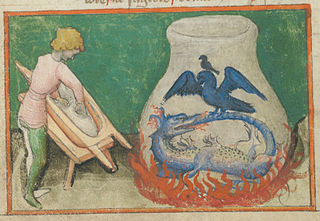
Alchemy is an ancient branch of natural philosophy, a philosophical and protoscientific tradition that was historically practiced in China, India, the Muslim world, and Europe. In its Western form, alchemy is first attested in a number of pseudepigraphical texts written in Greco-Roman Egypt during the first few centuries AD.

Rosicrucianism is a spiritual and cultural movement that arose in Europe in the early 17th century after the publication of several texts announcing to the world a new esoteric order. Rosicrucianism is symbolized by the Rosy Cross or Rose Cross.
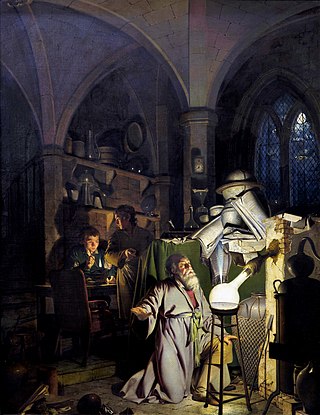
The philosopher's stone, or more properly philosophers' stone, is a mythic alchemical substance capable of turning base metals such as mercury into gold or silver. It is also called the elixir of life, useful for rejuvenation and for achieving immortality; for many centuries, it was the most sought-after goal in alchemy. The philosopher's stone was the central symbol of the mystical terminology of alchemy, symbolizing perfection at its finest, enlightenment, and heavenly bliss. Efforts to discover the philosopher's stone were known as the Magnum Opus.

Robert Fludd, also known as Robertus de Fluctibus, was a prominent English Paracelsian physician with both scientific and occult interests. He is remembered as an astrologer, mathematician, cosmologist, Qabalist and Rosicrucian.

Hermeticism or Hermetism is a philosophical and religious system based on the purported teachings of Hermes Trismegistus. These teachings are contained in the various writings attributed to Hermes, which were produced over a period spanning many centuries and may be very different in content and scope.
This article contains information about the literary events and publications of 1620.

Jakob Böhme was a German philosopher, Christian mystic, and Lutheran Protestant theologian. He was considered an original thinker by many of his contemporaries within the Lutheran tradition, and his first book, commonly known as Aurora, caused a great scandal. In contemporary English, his name may be spelled Jacob Boehme ; in seventeenth-century England it was also spelled Behmen, approximating the contemporary English pronunciation of the German Böhme.

The Emerald Tablet, also known as the Smaragdine Tablet or the Tabula Smaragdina, is a compact and cryptic Hermetic text. It was highly regarded by Islamic and European alchemists as the foundation of their art. Though attributed to the legendary Hellenistic figure Hermes Trismegistus, the text of the Emerald Tablet first appears in a number of early medieval Arabic sources, the oldest of which dates to the late eighth or early ninth century. It was translated into Latin several times in the twelfth and thirteenth centuries. Numerous interpretations and commentaries followed.

Michael Sendivogius was a Polish alchemist, philosopher, and medical doctor. A pioneer of chemistry, he developed ways of purification and creation of various acids, metals and other chemical compounds. He discovered that air is not a single substance and contains a life-giving substance—later called oxygen—170 years before Scheele's discovery of the element. He correctly identified this 'food of life' with the gas given off by heating nitre (saltpetre). This substance, the 'central nitre', had a central position in Sendivogius' schema of the universe.

Michael Maier was a German physician and counsellor to Rudolf II Habsburg. He was a learned alchemist, epigramist, and amateur composer.
Frater Albertus Spagyricus born May 5,(1911–1984); founder of the Paracelsus Research Society in Salt Lake City, which later evolved into the Paracelsus College. Based on the Paracelsian concept of three essentials, Body, Soul and Spirit, Frater Albertus developed a system of teaching alchemical concepts using the spagyric technique of separation and cohobation. The unique graduated courses allowed students to explore aspects of the vegetable, mineral and animal kingdoms in an understandable and accessible way. After his death in 1984, the college ceased operations in the United States but continued to carry on the tradition in Australia. Frater Albertus had a profound effect on the way Alchemy and particularly the Spagyric method was disseminated and understood in the mid to late 20th century. His works were translated into many languages. He was a rosicrucian.
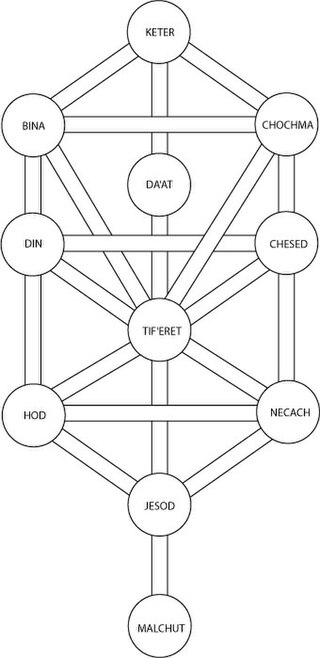
The Tree of Life is a diagram used in Kabbalah and various other mystical traditions. It usually consists of 10 or 11 nodes symbolizing different archetypes and 22 lines connecting the nodes. The nodes are often arranged into three columns to represent that they belong to a common category.
Adam McLean is a Scottish writer on alchemical texts and symbolism. In 1978 he founded the Hermetic Journal which he published until 1992 during which time he also started publishing the Magnum Opus Hermetic Sourceworks, a series of 55 editions of key source texts of the hermetic tradition. From 2004 he began collecting tarot cards in order to document tarot art and built up a collection of 2500 items. In 2016 he set up the Surrealism Website in order to document surrealist painters. This currently shows the work of 100 surrealist artists. He also created a series of 20 video lectures on many facets of surrealist paintings. In 2017 he set up an art gallery The Studio and Gallery in Kilbirnie in North Ayrshire in order to promote the work of emergent and lesser-known artists.

Bibliotheca Philosophica Hermetica (BPH) or The Ritman Library is a Dutch library founded by Joost Ritman located in the Huis met de Hoofden at Keizersgracht 123, in the center of Amsterdam. The Bibliotheca Philosophica Hermetica brings together manuscripts and printed works in the field of Hermeticism, more specifically the 'Christian-Hermetic' tradition.

Musaeum Hermeticum is a compendium of alchemical texts first published in German, in Frankfurt, 1625 by Lucas Jennis. Additional material was added for the 1678 Latin edition, which in turn was reprinted in 1749. Its purpose was apparently to supply in a compact form a representative collection of relatively brief and less ancient alchemical writings; it could be regarded as a supplement to those large storehouses of Hermetic learning such as the Theatrum Chemicum, or Jean-Jacques Manget's Bibliotheca Chemica Curiosa. It seemed to represent a distinctive school in Alchemy, less committed to the past and less obscure than the works of older and more traditional alchemical masters.
Wu-liu pai, or Wu-liu fa pai, also known as Xianfo — a school of Taoism with main focus on internal alchemy (neidan).

The Rosary of the Philosophers is a 16th-century alchemical treatise. It was published in 1550 as part II of De Alchimia Opuscula complura veterum philosophorum (Frankfurt). The term rosary in the title is unrelated to the Catholic prayer beads; it refers to a "rose garden", metaphoric of an anthology or collection of wise sayings.

Cleopatra the Alchemist was a Greek alchemist, author, and philosopher. She experimented with practical alchemy but is also credited as one of the four female alchemists who could produce the philosopher's stone. Some writers consider her to be the inventor of the alembic, a distillation apparatus.
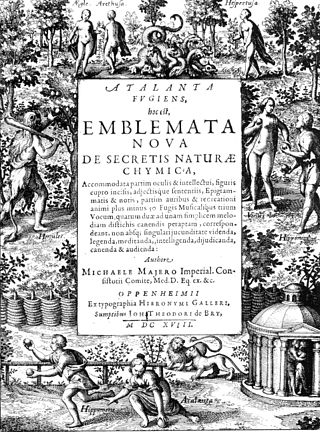
Atalanta Fugiens or Atalanta Fleeing is an emblem book with an alchemical theme by Michael Maier (1568–1622), published by Johann Theodor de Bry in Oppenheim in 1617. It consists of 50 discourses with illustrations by Matthias Merian, each of which is accompanied by an epigrammatic verse, prose and a musical fugue. It may therefore be considered an early example of multimedia.
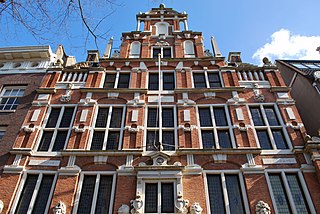
The Embassy of the Free Mind is a museum, library and platform for free thinking, inspired by the philosophy of the Bibliotheca Philosophica Hermetica collection. The museum focusses on the European culture of free thinking of the past 2.000 years, with Hermetic wisdom as the source of inspiration: insight into the connection between God, cosmos and man. This connection is reflected in the Hermetic, alchemical, astrological, magical, mystical, kabbalistic and Rosicrucian texts and images in the collection.
















